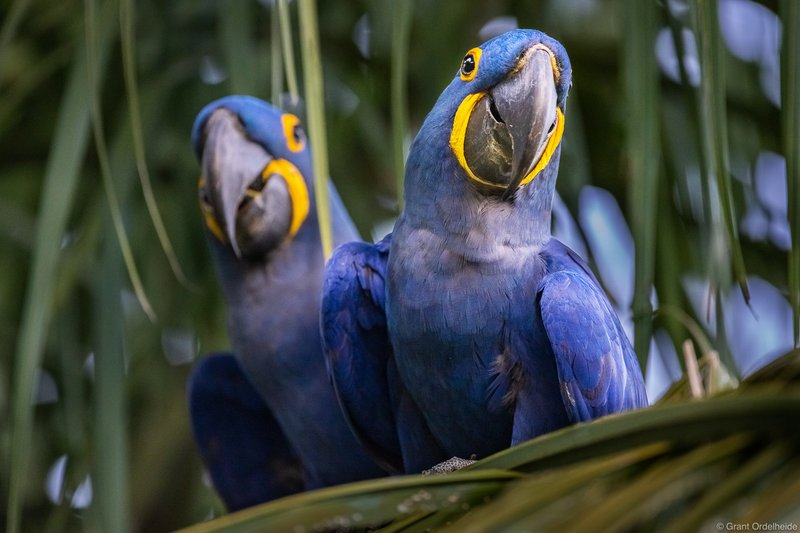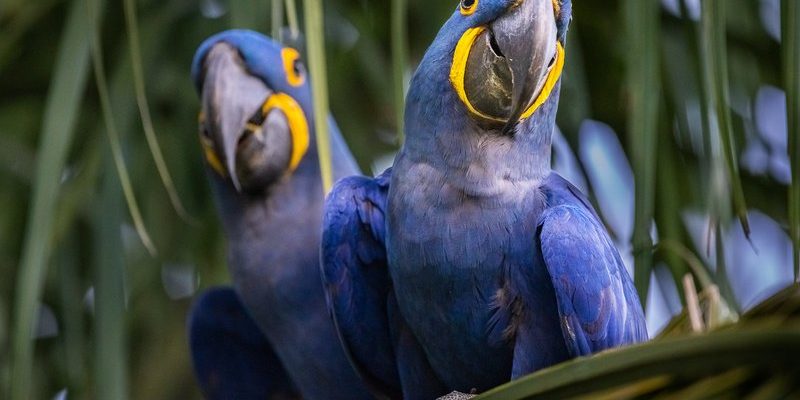
When you sit down to observe a Hyacinth Macaw, you might notice that their vocalizations range from soft chirps to loud screeches, much like how a good friend might whisper in your ear or call out to grab your attention across a crowded room. Understanding what these sounds mean can deepen your appreciation for these magnificent creatures and help you interpret their behavior more effectively.
In this article, we’ll dive into the fascinating world of Hyacinth Macaw vocalizations. We’ll explore the different sounds they make, the emotions associated with these calls, and what it all means in the context of their behavior. So, let’s crack open this colorful conversation and discover the language of the Hyacinth Macaw!
Understanding Hyacinth Macaw Communication
Hyacinth Macaws, known scientifically as *Anodorhynchus hyacinthinus*, are the largest flying parrots. They are native to the tropical forests of South America and possess an incredible range of vocalizations that serve various purposes. Just like humans use different tones for different situations—think of how you speak softly to a baby but raise your voice when you want to be heard in a noisy room—Hyacinth Macaws do the same.
These birds have been observed using vocalizations to attract mates, warn of dangers, or simply communicate with each other in their flocks. Their ability to vocalize effectively is essential for their survival, especially in the wild where clear communication can mean the difference between life and death. Curious about their sounds? Let’s break it down!
Types of Vocalizations
Hyacinth Macaws have a variety of sounds, each serving a specific role. Here are some of the main types you might hear:
- Contact Calls: These are the everyday sounds, like a friendly “hello,” used to maintain connection with their flock.
- Alarm Calls: A sharp, loud call that warns others of potential threats, much like shouting, “Look out!”
- mating Calls: A series of soft coos and whistles used to attract a partner during the breeding season, similar to sweet talk.
- Play Calls: These fun, energetic sounds often occur during play or social interactions, akin to laughter among friends.
Each vocalization helps the Hyacinth Macaw express its needs and feelings. By paying attention, you can start to understand what they’re trying to communicate!
The Meaning Behind the Sounds
Now that we know the types of vocalizations, let’s explore what these sounds might really mean. It’s not just about the noise; it’s about the context. Here’s where it gets interesting!
Contact Calls typically indicate a desire to stay connected. If you’re watching a pair of macaws, and one starts making these calls, they might be checking in or reassuring their partner that everything is okay. It’s like sending a text just to say, “Hey, I’m here!”
Alarm Calls are louder and more urgent. If a predator approaches, a Hyacinth Macaw will let out a sharp call, signaling their flock to fly to safety. Think of it as sounding the alarm when something feels off. The tone and intensity can vary based on the level of threat.
During mating season, mating calls come into play. These softer sounds are intended to attract a mate. The rhythm and pitch can vary depending on each bird’s personality. Just imagine a romantic serenade on a sunny afternoon—these calls create a perfect ambiance for courtship.
Lastly, play calls indicate social interactions. Young macaws often engage in playful vocalizations, which show their excitement and help strengthen social bonds. These sounds can get quite creative, resembling playful banter among friends.
Why Vocalizations Matter
Understanding the vocalizations of Hyacinth Macaws isn’t just for bird enthusiasts—it’s crucial for their welfare too. If you’re a pet owner, recognizing these sounds can help you meet your macaw’s needs better. For instance, if your macaw is squawking loudly, it’s a cry for attention or perhaps a sign they’re bored.
Hyacinth Macaws are intelligent creatures. They thrive on social interaction and mental stimulation. If they feel neglected, they may resort to repetitive vocalizations or destructive behaviors. So, knowing their vocal language means you can engage with them meaningfully and provide a healthier environment.
Moreover, understanding vocalizations plays a vital role in conservation efforts. As their habitats are threatened, monitoring their communication can provide insights into their social dynamics and behaviors. This knowledge is essential for protecting them in the wild and ensuring their survival.
Recognizing Emotions Through Vocalizations
Vocalizations are not just sounds; they are valuable indicators of a Hyacinth Macaw’s emotional state. If you observe these birds closely, you might notice how their vocalizations change with different feelings.
For example, a Hyacinth Macaw that feels insecure or frightened may make higher-pitched, frantic calls, almost like a child crying for help. In contrast, a confident, happy macaw will produce deeper, more relaxed notes, echoing joy. Just like how our voices can reflect happiness or anxiety, bird voices tell a similar story.
Furthermore, behavioral cues often accompany vocalizations. If a macaw is grooming another while making soft cooing sounds, they’re likely expressing affection. However, if they’re puffing up their feathers and screeching loudly, it might be a warning to stay away!
Recognizing these emotional signals can significantly enhance your relationship with a Hyacinth Macaw, whether in the wild or as a pet. It fosters empathy and understanding, enabling you to respond appropriately.
The Role of Environment in Vocalizations
The environment plays a critical role in how Hyacinth Macaws vocalize. In the wild, they live in dense forests where vocalizations help them communicate over long distances. Their loud screeches can carry for miles, ensuring they stay connected with their flock, even when separated by thick foliage.
In captivity, however, the dynamics change. The lack of space can lead to varied vocalization patterns. If a macaw feels isolated, it may vocalize more frequently as a way to seek companionship. A well-structured environment, filled with toys and social opportunities, helps reduce excessive calling.
Here’s a helpful analogy: Imagine living in a bustling city where sounds and interactions are all around. Now, picture a quiet, rural area where the only noise is a gentle breeze. Your vocal habits would likely shift based on your surroundings. Birds are no different.
Creating an enriching environment, whether through socialization or engaging activities, fosters a happier, more vocal macaw. This can significantly enhance their quality of life.
Training and Vocalizations
Training Hyacinth Macaws goes hand in hand with understanding their vocalizations. Using positive reinforcement techniques can teach them to mimic sounds or even words. This can lead to some entertaining moments!
When training, pay attention to their vocal cues. If they start making sound patterns in response to commands, it’s an indication they’re processing information. For example, you might say “hello” and hear a cheerful chirp in return. This back-and-forth can strengthen your bond and make training sessions more fun.
However, it’s essential to maintain a realistic expectation. Not all macaws will vocalize or mimic sounds, and that’s perfectly okay! Each bird has its unique personality, so finding what works best for your feathered friend is key.
Remember, training should always be a positive experience for both you and the macaw. Celebrate small victories, and always be attentive to their vocalizations for clues about how they’re feeling during the process.
Hyacinth Macaws are fascinating creatures with a diverse range of vocalizations that tell a lot about their emotions and intentions. By paying attention to their sounds and understanding what they mean, whether in the wild or as pets, we can foster better relationships with these magnificent birds.
From joyful calls to warnings, their vocal language adds another layer to their charming personalities. By creating enriching environments, practicing positive reinforcement during training, and tuning into their vocal cues, we can ensure these birds live happy, fulfilling lives.
So next time you hear the chatter of a Hyacinth Macaw, take a moment to listen closely. You just might discover a whole new world of communication waiting to be understood.

